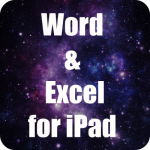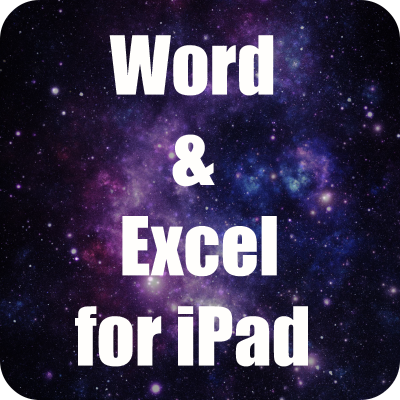 Microsoft’s Office for iPad was a long time coming, and indeed the delay has allowed plenty of alternatives
Microsoft’s Office for iPad was a long time coming, and indeed the delay has allowed plenty of alternatives![]() to get their foot in the market door, some of which are now thriving and are fully integrated into some larger organizations’ mobile and cloud service strategies.
to get their foot in the market door, some of which are now thriving and are fully integrated into some larger organizations’ mobile and cloud service strategies.
The debate surrounding how useable Office for iPad would end up being as compared to its competitors naturally grew and grew in lieu of an actual release. But, now that it’s here, how do the two most frequently used applications of the Office suite fair? Well, actually quite well.
Microsoft Office For iPad
There are 3 apps available for Office on iPad – PowerPoint, Word and Excel. The actual apps are in fact free – however, if you actually want to be able to edit your presentations, documents and spreadsheets with them then you will need to set up an Office 365![]() account. The set up is very straightforward – although it should be noted that if you subscribe via one of the apps directly then only an annual subscription is available, whereas a month-by-month alternative can be organized if you prefer through the Microsoft site.
account. The set up is very straightforward – although it should be noted that if you subscribe via one of the apps directly then only an annual subscription is available, whereas a month-by-month alternative can be organized if you prefer through the Microsoft site.
MS Word
 Microsoft Word is not only the most widely used of the three Office apps but is also the one fending off the most competition. The biggest and fiercest of these competitors is of course Apple’s Pages
Microsoft Word is not only the most widely used of the three Office apps but is also the one fending off the most competition. The biggest and fiercest of these competitors is of course Apple’s Pages![]() , which supports a huge range of file types, along with images and media, layout capabilities, style elements, templates and of course a full range of interesting fonts.
, which supports a huge range of file types, along with images and media, layout capabilities, style elements, templates and of course a full range of interesting fonts.
However, Word really is still the industry leader, both in popularity as well as usability. So how well does it transfer across to the iPad?
Very well, actually. It looks like Word, it feels like Word, it behaves like Word – it is Word, for most intents and purposes. The core features are all still there, and what’s more, they’re in exact places that you’d expect to find them (provided, of course, that you’ve used Word before – which is surely everybody, right?). The toolbar ribbon at the top of all documents is still there, albeit a little stripped down so as to accommodate the smaller screen.
But the similarities to its desktop bigger brother don’t end there. The Track Changes feature, perhaps the most useful to business users of Word, with its ability to review, accept/reject changes to a document is pretty much identical. The ability to insert comments is the same too.
Word – What’s Missing?
There are a few features, however, that you won’t find on the iPad version of Word. There is no option, for instance, for creating new styles – you are limited to the default Word style for all documents. There is also no option to print directly from Word.
So, all in all, Word for iPad is very similar indeed to Word for desktop, so in the end it will just come down to user preference. If you’ve been using Pages for some time now (and it’s been available in iOS for four years already) then you’ve probably got used to it – however, newcomers who’ve always used Word and Office will find themselves right at home here.
MS Excel
 Again, the similarities between Excel for iPad and the classic Excel for desktop are what gives the iPad version its greatest advantages. Indeed, familiarity is what’s key to working with spreadsheets, and so for the regular desktop user of Excel, when it comes to the iPad version, you’re already fully equipped.
Again, the similarities between Excel for iPad and the classic Excel for desktop are what gives the iPad version its greatest advantages. Indeed, familiarity is what’s key to working with spreadsheets, and so for the regular desktop user of Excel, when it comes to the iPad version, you’re already fully equipped.
The ribbon is again there, stripped a little to accommodate the screen size, however the core functions remain intact. The whole feel, actually, is very similar to Excel for desktop and it performs in a very intuitive manner.
There is a slight issue – albeit one that can’t really be avoided – in that the onscreen keyboard does unfortunately obscure quite a lot of the spreadsheet. This is always going to be a problem for such a program on the iPad, as the keyboard has to go on the screen somewhere, and it has to be big enough to be of use. However, there is an optional keyboard that can be summoned which is actually very functional. Along with the numeric keypad, it contains all the common symbols used, arrow keys and a dedicated tab key. It is well designed and allows you to enter data very quickly and intuitively – as with all things on the touch screen, it just takes a little getting used to.
Excel – What’s Missing?
Again, it’s the more advanced features that unfortunately haven’t found their way onto the iPad version. Macros and pivot tables aren’t supported, and again there is no way to print directly from Excel – although one suspects that as the updates come through this may well be one of the first issues that get addressed. You cannot track changes either like you can on Word for iPad, which is quite a significant let down, and comments are only partially supported – you may only view and delete comments and not create and edit new ones.
All in all Word and Excel for iPad are very useable apps indeed, and there are really only a limited amount of advanced features that haven’t made the transfer. The designs have been very well thought out to accommodate the touchscreen and the overall experience is very intuitive and user friendly – if you can stomach the Microsoft 365 subscription ($69.99 – $99.99 a year) and you want to work in Office then this may well be the option for you.
